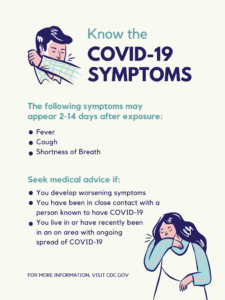According to the Centers for Disease Control and Prevention (CDC), influenza (flu) and COVID-19 are both contagious respiratory illnesses, but they are caused by different viruses. They have many similarities and some important differences.
Since many of their symptoms are similar, it may be hard to tell them apart. The following will help you understand what features the two viruses have in common, and which are unique to each.
SYMPTOMS
Common to both: Fever or feeling feverish/chills, cough, fatigue (tiredness), sore throat, runny or stuffy nose, muscle pain or body aches, headache, or diarrhea and vomiting (more common in young children with influenza). New onset of shortness of breath or difficulty breathing has been reported with COVID-19 infection. These symptoms also can occur with influenza infection, but are usually seen among those with severe illness or other complications of influenza, such as pneumonia. For both viruses, symptoms can range from no symptoms (asymptomatic) to severe. It’s important to note that it is possible to spread the flu or COVID-19 when you are asymptomatic.
COVID-19 only: One symptom that is unique to COVID-19 is a change in (or new loss of) taste or smell.
HIGH-RISK GROUPS
Common to both: Older adults, people with certain underlying medical conditions, and pregnant women.
TRANSMISSION
Common to both: Both COVID-19 and flu can spread from person-to-person, especially those who are in close contact with one another. Frequent handwashing, mask wearing, covering coughs and sneezes, social distancing, and regular cleaning of high-touch surfaces are all ways to reduce the spread of both viruses.
COVID-19 only: COVID-19 is transmitted through smaller droplets that are dispersed into the air when people with the illness cough, sneeze, or talk. These small droplets make it easier for COVID-19 to spread from one person to another because they can be inhaled through the nose or mouth or can enter through the mucous membranes of the eyes.
Flu only: Influenza is transmitted through large droplets that are made when people with the illness cough, sneeze, or talk. These droplets can then land on surfaces. If a person touches a surface or object that has virus on it and then touches his or her own mouth, nose, or possibly their eyes, they may get infected.
CONTAGIOUS PERIOD
COVID-19 only: Most people who become infected with COVID-19 develop symptoms within 5 days. However, symptoms can develop anywhere from 2-14 days after initial infection. A person infected with COVID-19 may be contagious to others beginning 48 hours before symptoms develop and may remain contagious for up to 10 days after symptoms first appear. People with severe illness or people with weakened immune systems can be contagious for up to 20 days from when symptoms first appear.
Flu only: Most people infected with the flu develop symptoms within 1 to 4 days. Those infected with the flu can be contagious to others beginning one day before symptoms develop. They are most contagious during the initial 3-4 days of their illness, but many remain contagious for about 5-7 days after symptoms begin. Children and people with weakened immune systems may pass the virus for longer than 7 days.
COMPLICATIONS
Common to both: Both COVID-19 and flu can result in complications, especially among those at high risk. Some complications include pneumonia, sepsis, or organ failure.
COVID-19 only: COVID-19 also can cause life-threatening blood clots in the veins and arteries of the lungs, heart, legs, or brain.
RECOVERY
COVID-19 only: The recovery time frame for COVID-19 can vary depending upon severity of illness, but most people experience improved symptoms within 10 days.
Flu only: Most people with the flu will recover in a few days to less than two weeks.
VACCINATIONS
COVID-19 only: Currently there is no approved vaccine against COVID-19.
Flu only: There are multiple, safe influenza vaccines produced annually, including a special high-dose vaccine for people 65 and older. The CDC is strongly recommending vaccination against influenza for 2020-2021 season.
Protect yourself with a flu shot!
The best way to protect yourself against the flu is to get vaccinated. It is a simple step you can take to protect yourself, your loved ones, and others in the community.
The CDC is strongly recommending that everyone 6 months or older get a flu vaccine by the end of October.
Getting a flu vaccine is more important than ever during 2020-2021 to protect yourself and the people around you from flu, and to help reduce the strain on health care systems responding to the COVID-19 pandemic. If we can keep more people healthy this winter, we can ensure that resources are available to care for those who are critically ill from influenza, COVID-19, or other serious medical conditions.
Are flu vaccines safe?
Yes. For more than 50 years, hundreds of millions of Americans have safely received seasonal flu vaccines.
What to do if you’re not sure if you have the flu, COVID-19, or something else
Contact your physician to discuss your concerns and follow their advice regarding testing, treatment, and symptom management.
About the Author: Bayada: When you connect your clients with BAYADA, a nationwide company, for high-quality personal care and household support services, you can trust that we are committed to keeping them safe at home as long as possible. That means independence for them and peace of mind for their families. With BAYADA as a partner, you and your clients can rely on 24/7 clinical support, long-term care insurance expertise, best-matched and trained caregivers who love what they do, and ongoing communication and collaboration. BAYADA is also a Corporate Partner of ALCA and the Sapphire-Level Conference Sponsor.
